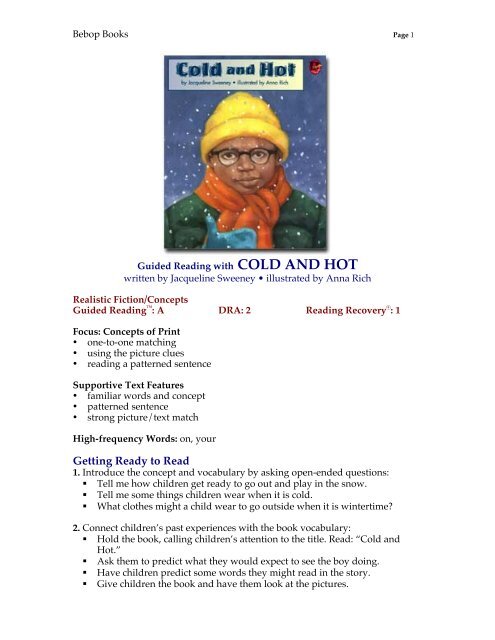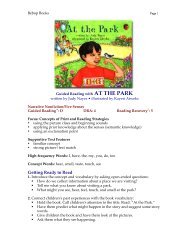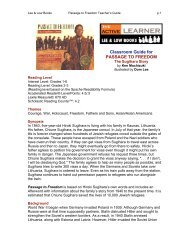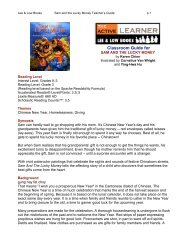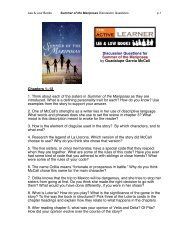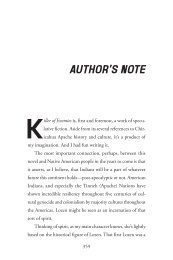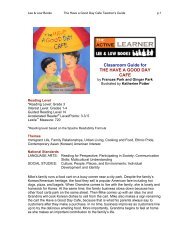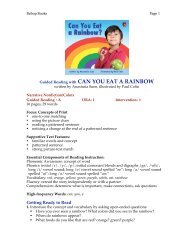You also want an ePaper? Increase the reach of your titles
YUMPU automatically turns print PDFs into web optimized ePapers that Google loves.
Bebop <strong>Books</strong> Page 1Guided <strong>Read</strong>ing with COLD AND HOTwritten by Jacqueline Sweeney • illustrated by Anna RichRealistic Fiction/ConceptsGuided <strong>Read</strong>ing : A DRA: 2 <strong>Read</strong>ing Recovery ® : 1Focus: Concepts of Print• one-<strong>to</strong>-one matching• using the picture clues• reading a patterned sentenceSupportive Text Features• familiar words and concept• patterned sentence• strong picture/text matchHigh-frequency Words: on, your<strong>Getting</strong> <strong><strong>Read</strong>y</strong> <strong>to</strong> <strong>Read</strong>1. Introduce the concept and vocabulary by asking open-ended questions: Tell me how children get ready <strong>to</strong> go out and play in the snow. Tell me some things children wear when it is cold. What clothes might a child wear <strong>to</strong> go outside when it is wintertime?2. Connect children’s past experiences with the book vocabulary: Hold the book, calling children’s attention <strong>to</strong> the title. <strong>Read</strong>: “Cold andHot.” Ask them <strong>to</strong> predict what they would expect <strong>to</strong> see the boy doing. Have children predict some words they might read in the s<strong>to</strong>ry. Give children the book and have them look at the pictures.
Bebop <strong>Books</strong> Page 2Ask them what this boy put on <strong>to</strong> go outside.3. Remind children of the strategies they know and can use with unfamiliarwords: Ask them, “What will you do if you come <strong>to</strong> a word you don’t know?” Encourage children <strong>to</strong> look at the pictures and the beginning sound of theword.4. Be aware of the following text features: The book contains familiar words: coat, hat, scarf, mittens, boots. There is a patterned sentence: “Put on your boots.” Only one word changes on each page. The first and last sentences are different: “I’m cold!” and “I’m hot!”<strong>Read</strong>ing the Book1. Set a purpose by telling children <strong>to</strong> read the book and find out what the boyput on when he was going outside <strong>to</strong> play.2. Have children read quietly, but out loud. Each child should be reading at hisor her own pace. Children should not read in chorus. Listen <strong>to</strong> children as theyread by leaning close or bending down beside each child.3. Look for these reading behaviors during the first reading: Do the words they say match the printed words in the book? (voice <strong>to</strong> printmatch) Do they look at the pictures before they read the text or after they read? What do they do if they encounter an unfamiliar word? (appeal <strong>to</strong> you, trya strategy) Do their eyes go up <strong>to</strong> the picture before reading the new word in thepattern? Are they saying the initial sounds of words before saying the whole word? Are they saying the individual letter sounds /c/ - /o/ - /a/ - /t/ orblending the sounds? Do they reread if they come <strong>to</strong> an unfamiliar or unknown word? Have they self-corrected any mistakes? Is there any inflection or speech-like sound <strong>to</strong> their reading? Have they responded with a laugh or other sound as they read the text? Do they make comments as they read?4. As children read, suggest a reading strategy if they are struggling: “Trylooking at the picture <strong>to</strong> make sense of the print.” Encourage children <strong>to</strong> take aguess or use the beginning letter sound.5. Possible teaching points <strong>to</strong> address based on your observations: Review using the picture <strong>to</strong> help with each new word. Review using the beginning sound. Model how <strong>to</strong> reread the sentence if it doesn’t sound right or make sense. Call attention <strong>to</strong> the high-frequency words children have learned and used.
Bebop <strong>Books</strong> Page 3After the First <strong>Read</strong>ing1. Have children confirm their predictions about the boy and the clothes hewears.2. Ask children <strong>to</strong> explain why the boy says “I’m cold!” at the beginning of thes<strong>to</strong>ry but “I’m hot!” at the end of the s<strong>to</strong>ry.3. Discuss how the boy starts out saying he is cold and then at the end says he ishot. Use this discussion <strong>to</strong> introduce the concept of cause and effect.4. Reflect on what would have happened if the boy had gone outside without allthe extra clothes. Ask: “Which of the clothes were essential? Which clothes areneeded on very cold days and which would be enough for a chilly day?”5. Discuss other times when someone might first feel cold and then hot. Also,brains<strong>to</strong>rm some times when someone might first feel hot and then cold.6. Make a set of directions for getting ready <strong>to</strong> go outside <strong>to</strong> play in the snow.Turn the directions in<strong>to</strong> a poster or a note from mom using modeled writing.Second <strong>Read</strong>ing1. Have children reread the book in a whisper voice or <strong>to</strong> a partner.2. This is a time for assessment. While they are reading, watch what children doand what they use from the teaching time. Alternatively, you might take arunning record on one student as an assessment of the student’s readingbehavior.Cross-Curricular ActivitiesLanguage: Give children pictures of clothing and have them sort the picturesin<strong>to</strong> two piles: clothes for warm weather and clothes for cold weather.Art: Give children paper dolls and have them cut out winter clothes for the doll.When the doll is finished it will be dressed for going out <strong>to</strong> play in the snow.Children can design and cut their own clothes or use templates for tracing.Art: Have children look through magazines and cut out pictures of peopleengaging in winter activities. Use the pictures <strong>to</strong> create a collage that representswintertime or cold weather activities.Science: Use a map and books about climate <strong>to</strong> explore where children wouldhave snow <strong>to</strong> play in during the winter.Science: Work with beakers of water at different temperatures. Have children<strong>to</strong>uch each one and decide if it feels hot or cold. Use a thermometer <strong>to</strong> check thetemperature of each sample. Put the beakers in order by temperature and havechildren <strong>to</strong>uch each one and talk about how the water feels as it changestemperature from low <strong>to</strong> higher. Reflect on where one would see cold water,warm water, and hot water. Brains<strong>to</strong>rm other words that describe temperature,i.e. chilly, just right, steaming, boiling, freezing, etc.
Bebop <strong>Books</strong> Page 4Math: Make a graph that illustrates what children are wearing. Then decide ifthe day is a hot, cold, warm, just right, or freezing day.Math: Make pairs of mittens and count by twos.Writing: Have children write s<strong>to</strong>ries about a time they had <strong>to</strong>o many clothes onand were uncomfortable. Encourage them <strong>to</strong> tell what changed as they gotwarmer.Guided <strong>Read</strong>ing with FRÍO Y CALORGuided <strong>Read</strong>ing : B DRA: 2 <strong>Read</strong>ing Recovery ® : 2The Spanish edition also uses a patterned sentence and familiar words: abrigo,gorro, bufanda, mi<strong>to</strong>nes, botas. Because many children speak dialects or maymix Spanish and English, it will be important <strong>to</strong> address the names for theclothing during the introduction. Help children understand that “book language”does not always match the words we use every day.The book introduction and guided reading lesson follow the outline for theEnglish edition. Children need exactly the same support and strategy instructionas their English-speaking classmates.If children have difficulty with concepts or words in the s<strong>to</strong>ry, see the article“Guided <strong>Read</strong>ing with Emergent <strong>Read</strong>ers” for suggestions.
Bebop <strong>Books</strong> Page 5Contact informationFor more information about Bebop <strong>Books</strong>, please contact:Craig <strong>Low</strong>, PublisherBebop <strong>Books</strong>An imprint of LEE & LOW BOOKS95 Madison Avenue, Suite #606New York, NY 10016212-779-4400 x. 26 ph.212-532-6035 faxclow@bebopbooks.comThe <strong>Read</strong>ing Recovery ® levels have been assigned by certified <strong>Read</strong>ing Recovery ® teachers and are not officiallyauthorized by <strong>Read</strong>ing Recovery ® . <strong>Read</strong>ing Recovery ® is a registered servicemark of The Ohio State University.The guided reading levels have been assigned by <strong>Read</strong>ing Recovery ® teachers using the guidelines identified in Guided<strong>Read</strong>ing and Matching <strong>Books</strong> <strong>to</strong> <strong>Read</strong>ers by Irene C. Fountas and Gay Su Pinnell (Heinemann). Use of The Fountas & PinnellGuided <strong>Read</strong>ing Leveling System, Copyright © Irene C. Fountas and Gay Su Pinnell, is by permission of Irene C.Fountas and Gay Su Pinnell.The DRA (Developmental <strong>Read</strong>ing Assessment) levels were determined using information in the Developmental <strong>Read</strong>ingAssessment Resource Guide by Joetta Beaver (Celebration Press).All level placements may vary and are subject <strong>to</strong> revision.Copyright © 2002 by Bebop <strong>Books</strong> ® , an imprint of <strong>Lee</strong> & <strong>Low</strong> <strong>Books</strong> Inc. Used with permission.


